- Nissan Cedric
-
- This article incorporates information from the equivalent article on the Japanese Wikipedia.
Contents
Nissan Cedric 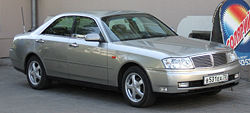
Manufacturer Nissan Production 1960–2004 Successor Nissan Fuga Class Executive car Body style 2-door coupe
4-door hardtop/Sedan/wagonRelated Nissan Cima
Nissan Leopard
Nissan Crew
Nissan GloriaThe Nissan Cedric is a large automobile produced by Nissan since 1960. It was developed to provide upscale transportation, competing with the Prince Skyline and Gloria which were later merged into the Nissan family. In later years, the Nissan Skyline was positioned as a sports sedan/coupe, whereas the Nissan Gloria was turned into a sporty version of the Cedric (with identical styling but using a different radiator grille and front & rear light clusters).
In Japan, the Cedric/Gloria series was affectionately called Cedglo, and this long running series finally came to an end in October 2004, replaced by the Nissan Fuga. The Cedric name is still in use, on the Y31 series fleet vehicle traditionally used as a taxi, where it competes with the Toyota Comfort, and is still in production. Throughout the many versions of the Cedric, it was always considered to be the prime competitor to the Toyota Crown. The hood ornament was inspired by the diamond pattern used by Lincoln but was changed to two right angles set next to each other.
The Cedric name was inspired by the main character, Cedric, in Francis Hodgson Burnett's novel "Little Lord Fauntleroy" by the Nissan CEO at the time Katsuji Kawamata.[citation needed]
First generation 30
Nissan Cedric 30 and 31 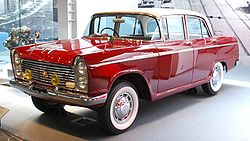

Also called Yue Loong YLN-801 (TW) Production 1960–1965 Body style 4-door sedan/wagon/van Layout FR layout Engine 1.5 L G I4
1.9 L H I4
2.8 L K I6
2.0 L SD20 diesel I4 (QGS31)Transmission Borg-Warner three-speed automatic
four-speed manualWheelbase 2,530 mm (99.6 in) Length 4,410–4,590 mm (173.6–180.7 in) Width 1,680 mm (66.1 in) Height 1,520 mm (59.8 in) Curb weight 1,195 kg (2,630 lb) The first Cedric was the "30" series, introduced in March 1960[1] and produced through 1962. Several models were available, including the Cedric 1500 DeLuxe and Standard (30), Cedric 1900 Deluxe (D30, powered by the 1.9 L Nissan H engine), Cedric 1900 Custom (G30, also powered by the Nissan H engine), Cedric Van (V30, six-seater) and the Cedric Wagon (WP30, eight-seater). Only the Cedric Standard used a 1.5 L (1,488 cc) G-series I4 engine which produced 71 PS (52 kW). The 1.9 L (1,883 cc) H-series with 88 PS (65 kW) was optional.[1] A four-speed manual transmission with the top three gears synchronized was standard, with a three-speed manual fitted to 1900 versions.
The Cedric replaced the Austin A50 Nissan was building under license from Austin Motor Company of England, which was called the Nissan Austin. The six-seater Cedric introduced Nissan's first monocoque body and a wrap-around windshield. The first Cedric featured two stacked headlights on either side of a large grille (inspired by a late 1950s commuter train from Japan, the Tobu JNR 151). The taillights were the same as the Datsun Bluebird 312. and was considered a six-seater. April 1962 saw the introduction of a station wagon–van, able to seat eight people.
31 Series
The "31" series was produced from 1962 until 1965. The models from the 30 series carried over to the 31 series with the addition of a few new models including the Cedric 1900 Standard (G31S) and a 2.0 L four cylinder SD20 diesel (QGS31) from June 1964. Also new was a three-speed automatic transmission, sourced from Borg Warner, which was offered from July 1964. The new front with its horizontally mounted quad headlights shows a resemblance to the 1956 Rambler and made the car 18 cm (7 in) longer.[1] In 1965, the pressed-steel tappet cover (valve cover) was replaced with an alloy version (same as the CSP311 Silvia). The taillights were smaller, and resembled MG units. All models were equipped with white wall tires. The Cedric was updated again in 1964 with a new dashboard, an alternator rather than a generator, and a new starter system. The Cedric 1500 Standard, first introduced in October 1962,[1] was dropped after 1964. The last change was the adoption of a new grille for the 1965 model year.
Cedric Special 50
The Cedric Special was produced between 1963 and 1965. It was a long-wheelbase version of the H31 series Cedric Custom, lengthened 145 mm (5.7 in) to fit the 115 PS (85 kW) 2.8 litre K-Series straight-six engine (an H engine with two extra cylinders). The grille is different from the one on the 31 series; it features a badge that said "Cedric Special", and the Cedric Star emblem. The side badges said "Cedric" and "Special". On the trunk lid (on the left side) is a "2800" badge, on the right side is a "Cedric Special" badge. The gold trim pieces on the hood were longer, and there was wheel arch and sill trim that was unique to the Cedric Special. The front bumper design is also different, with a raised section in the middle above the license plate. The interior was slightly more luxurious than the Custom. The only component that was identical to the Custom were the tail lights. The Mark I Special was produced in 1963, and was replaced by the Mark II in 1964. The Mark II was mostly the same as the Mark I except for a redesigned interior, new grille design (gold star emblem and separate gold letters spelling "Special"), rectangular reflectors below the tail lights (replacing the round reflectors used on the Mark I). An automatic transmission, the Borg-Warner 35, became available starting with the Mark II. The Mark II was produced in 1963 and 1964, and was replaced by the Mark III Special in 1964. The Mark III featured a new grille and tail lights from the 1965 31 Series Cedric. The Mark III Cedric Special was replaced by the Nissan President in 1965.
Second generation 130
Nissan Cedric 130 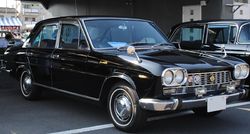
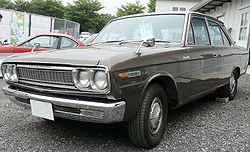
Also called Yue Loong 801-A (1964-1968 TW)
Yue Loong 801A (1968-1971 TW)
Datsun 2000
Datsun 2300
Datsun 2400Production 1965-1971 Assembly Miaoli, Taiwan Body style 4-door sedan/wagon/van Layout FR layout Engine 2.0L J20 Straight-6
2.0L L20 Straight-6
2.3L L23 Straight-6
2.4L L24 Straight-6
2.0 L H20 Straight-4
2.2 L SD22 Straight-4 dieselTransmission 3 speed automatic
4 speed manualWheelbase 2,690 mm (105.9 in) Length 4,680 mm (184.3 in) Width 1,690 mm (66.5 in) Height 1,455 mm (57.3 in) Curb weight 1,280 kg (2,800 lb) Produced from 1965 through 1971, the P130 Cedric had fashionable Pininfarina bodywork and several new engine options. Nissan's first OHC engine, the L20, was introduced in this generation Cedric.
On August 1966, Nissan Motor Company and Prince Motor Company merged.
Starting in 1967, the Cedric was sold on the export market (as Datsun 2000/2300/2400 rather than Nissan Cedric).
There were three body styles available: 4-door sedan, 5-door station wagon (Wagon Six from 1967, WP130, later WH130) and van (Van Six from 1968, also as Van Deluxe Six for 1970, VP130, later VH130)
Trim levels offered were the four-cylinder 130 (later called Standard) for 1966–1967, as 130S for 1968–1970. The Deluxe Six (P130, 1967.5-1970), Custom Six (P130D, dropped after 1966, reintroduced in 1970 as H130V), Standard (later called Personal Six, P130S, G130S), Personal Deluxe Six (G130Q, H130Q, replaced Personal Six for 1970), Standard Diesel (later called Diesel, Q130), and Special Six (also called Super Six, H130 for 1966–1967, G130 for 1969–1970, G130V for 1968 Super Six). In 1967, there were 68 model variations of the Cedric.
Engines:
- 1965-1971 2.0 L (1,983 cc) H20 OHV I4, 99 hp (74 kW) (4 Cylinder/Standard)
- 1965-1968 2.0 L (1,973 cc) J20 OHV I6, 109 hp (81 kW) (Deluxe, P130D Custom, P130S Personal, WP130 Wagon and Van)
- 1969-1971 2.0 L (1,998 cc) L20 OHC I6, 112 hp (84 kW) (H130V Custom, H130Q Personal Deluxe, WH130 Wagon, and Van Deluxe)
- 1965-1967.5 2.0 L (1,998 cc) L20 OHC twin-carb I6, 123 hp (92 kW) (H130 Special Six and H130 Super Six)
- 1968 2.3 L (2,263 cc) L23 OHC I6, 123 hp (92 kW) (1968 G130 Special Six and 1968 G130V Super Six)
- 1969-1971 2.4 L (2,393 cc) L24 OHC I6, 130 hp (97 kW) (G130Q Personal Deluxe, G130 Special Six, and G130 Super Six)
- 1965-1971 2.2 L (1,991 cc) SD20 OHV Diesel I4, 70 hp (51 kW) (Diesel)
This was the first Cedric that was available in versions no longer regarded as compact sedans under Japanese vehicle classification regulations, since the engines' displacement exceeded two litres.
Third generation 230
Nissan Cedric 230
Also called Nissan Gloria
Yue Loong 803 (TW)
Datsun 200/220/240/260CProduction 1971-1975 Assembly Miaoli, Taiwan Body style 2-door coupe
4-door hardtop/sedan/wagon/vanLayout FR layout Engine 2.0L H20 I4
2.0L L20A I6
2.4L L24 I6
2.6L L26 I6
2.0L SD20 I4 diesel
2.2L SD22 I4 dieselTransmission 3 speed automatic
4 speed manual
5 speed manualWheelbase 2,690 mm (105.9 in) Length 4,690 mm (184.6 in) Width 1,690 mm (66.5 in) Height 1,455 mm (57.3 in) Curb weight 1,345 kg (2,970 lb) The 230 series appeared in 1971 and was produced through 1975. The Cedric name was dropped for most export markets, with the car now called the Datsun 200C, 220C, 240C, 260C. The Nissan Gloria was introduced after the Prince Motor Company had been merged with Nissan. The 230 series was offered in 4 door sedan and wagon, and saw the introduction of a 2 door coupe. The coupe was introduced as a result of the 1970 Toyota Crown hardtop coupe.
Front disc brakes were added to the standard equipment list.
On August 1972, a 4 door hardtop sedan, with no "B" pillar between the front and rear passenger side windows was added to the options list. The 4 door hardtop had a standard interior dome light and a secondary fluorescent lamp that extended from the front to rear passenger seats, attached to the ceiling for ambient purposes. The Cedric was now being built at the Tochigi factory location. The suspension configuration remained the same type used in the second generation. The 3.0 L engine was replaced with the 2.6 L to conform to emission regulations enacted in April 1973.
The trim levels offered were the 2600 GX, the Custom 2600 DX, and the DX.
Engines:
- 2.0 L (1982 cc) H20 OHV I4 - 92 PS (68 kW), 140 km/h
- 2.0 L (1991 cc) SD20 OHV Diesel I4
- 2.0 L (1998 cc) L20A OHC I6 - 115 PS (85 kW), 165 km/h
twin-SU carb version (GX): 125 PS (92 kW), 170 km/h[2] - 2.2 L (2164 cc) SD22 OHV Diesel I4
- 2.4 L (2393 cc) L24 OHC I6 (1971–1972)
- 2.6 L (2565 cc) L26 OHC I6 (1972–1975) - 140 PS (103 kW)
Fourth generation 330
Nissan Cedric 330 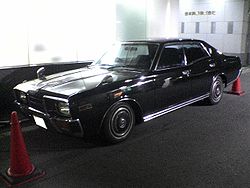
Also called Nissan Gloria
Yue Loong 805 (TW)
Datsun 200/220/260/280CProduction 1976-1979 Body style 2-door coupe
4-door hardtop/sedan/wagon/vanLayout FR layout Engine 2.0L L20 Straight-6
2.6L L26 Straight-6
2.8L L28 Straight-6
2.0L H20 Straight-4
2.2L SD22 Straight-4 diesel
2.0L SD20 Straight-4 dieselTransmission 3 speed automatic
4 speed manual
5 speed manualWheelbase 2,690 mm (105.9 in) Length 4,785 mm (188.4 in) Width 1,705 mm (67.1 in)) Height 1,440 mm (56.7 in) Curb weight 1,440 kg (3,200 lb) The 330 series Cedric was produced from 1976 through 1979. Again, it was sold as the Gloria as well in the domestic Japanese market; in the export it was marketed as the 200C, 220C, 260C, and 280C (after 1978).
The diesel engine returned, mainly for taxi usage. For the same purpose, there was a version of the petrol engine which ran on LPG. The engines were further modified as emission control regulations were again adjusted in 1976.
Trim levels offered were the Deluxe, Custom Deluxe, GL, GL-E, SGL, SGL-E, 2800SGL, and 2800SGL-E. The SG Brougham also first appeared in this generation. The "SG" designation stands for Senior Grade, and the "E" represents fuel injection.
October 1977 saw 1 million Cedrics produced.
Halogen headlights were added in June 1976.
Engines:
- 2.0 L (1,982 cc) H20 OHV I4
- 2.0 L (1,998 cc) L20A OHC I6
- 2.4 L (2,393 cc) L24 OHC I6
- 2.6 L (2,565 cc) L26 OHC I6 (1976–1978)
- 2.8 L (2,753 cc) L28 OHC I6 (1978–1979)
- 2.0 L (1,991 cc) SD20 OHV Diesel I4
- 2.2 L (2,164 cc) SD22 OHV Diesel I4
As with the 230, the 330 also came in the following body shells: Sedan, Wagon/Van, Coupé, and rare pillarless Hardtop Sedan.
Datsun 260C, 2 door coupé, right-hand drive.
Fifth generation 430
Nissan Cedric 430 
Also called Nissan Gloria
Datsun 220C/280C
Yue Loong 806/807 (2.0/2.4) (TW)Production 1979-1983 Assembly Miaoli, Taiwan Body style 4-door sedan/hardtop
5-door wagon/vanLayout FR layout Engine 2.0 L H20 I4
2.0 L L20S/L20E I6
2.0 L L20ET turbo I6
2.8 L L28 I6
2.0 L SD20 diesel I4
2.2 L SD22 diesel I4
2.8L LD28 diesel I6Transmission 4-speed manual
5-speed manual
3-speed automatic
4-speed automaticWheelbase 2,690 mm (105.9 in) Length 4,695–4,885 mm (184.8–192.3 in) Width 1,695–1,715 mm (66.7–67.5 in)) Height 1,430 mm (56.3 in) Curb weight 1,470 kg (3,200 lb) The 430 series was produced from 1979 through 1983. Engines largely carried over from the previous generation. Most export markets received the 2.8 L L28 OHC I6 or the LD28 diesel version, and was called the Datsun 280C.[3] For taxi use in Singapore and Hong Kong, the 2.2 liter diesel engine was still available in what was called the 220C. The engine gained fuel injection in 1982. Styling was achieved with the cooperation of Pininfarina, providing a cleaner image than the previous generation. The rear suspension was upgraded to a rigid link coil system. A lock-up torque converter was added to the four-speed automatic transmission, which was added in June 1982.[3] A convertible version was made available in small numbers for special use. This was the first generation Cedric with available four-wheel disc brakes, although drums all around were fitted to the cheapest versions.
The 2.0L turbocharged L20ET first appeared in December 1979, a first for the Japanese market. The trim level of SGL-F became available with the turbocharged engine from April 1981.
The diesel engine that had been first introduced with the previous generation was complemented by a 2.8 L inline-six diesel, a first for the Japanese market. This, the LD28, was introduced in January 1980, somewhat later than petrol versions, and remained in production until September 1985. Mainly for taxi and fleet use the 2 and 2.2 litre four-cylinder SD-series engines also remained available.[3] These lower-spec models receive four round headlights.
The two-door coupé was no longer offered, and was replaced by the Bluebird-based Nissan Leopard luxury sports coupé.
The 430 series Cedric was assembled and sold in Taiwan as the Yue Loong Cedric 2.0 and 2.4. At first codenamed 806, it became the 807 after a minor facelift.
Sixth generation Y30
Main article: Nissan 300CNissan Cedric Y30 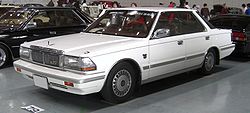

Also called Nissan Gloria
Yue Loong Cedric 811
Yue Loong 830 (TW)
Nissan 300CProduction 1983-1987 Assembly Miaoli, Taiwan Body style 4-door hardtop/sedan/wagon/van Layout FR layout Engine 3.0 L VG30ET turbo V6
3.0 L VG30E V6
2.0 L VG20ET turbo V6
2.0 L VG20 V6
2.8 L LD28 Straight-6 dieselTransmission 3 speed automatic
4 speed automatic
4 speed manual
5 speed manualWheelbase 2,730 mm (107.5 in) Length 4,860 mm (191.3 in) Width 1,720 mm (67.7 in)) Height 1,425 mm (56.1 in) Curb weight 1,475 kg (3,250 lb) The Y30 was sold from 1984 through 1987. It used the 3.0 L (2,960 cc) VG30E V6 for the 300C private cars. The diesel engine was used for taxi in Japan, Singapore, and Hong Kong. In Taiwan, the Y30 was sold as the Yue Loong Cedric 811 with a 2-litre four, or as the Cedric 830 with the three-litre VG30 six.[4]
The front suspension was upgraded from double wishbone to MacPherson strut, with optional sonic modified suspension.
This generation saw the introduction of the VG series V6, which was inspired by an Alfa Romeo design.
The sedan was meant to target the German luxury executive cars that dominated the class in the 80s (Mercedes S-Class, BMW 7-series). Trimmed in moquette cloth, the car featured adjustable front seats, adjustable steering wheel, power steering, air conditioning, tinted windows, a LW/MW/FM stereo/cassette player, and the V30 3.0L V6. The sedan featured the same independent front suspension as the wagon, but had a five-link suspension system for ride quality. A five-speed manual gearbox and the V6 engine gave the sedan a max speed of 190 km/h (118 mph), with 0-60 mph being achied in about 8.4 seconds.
On the 4-door hardtop, the front driver and passenger seat belt shoulder strap was connected at the top to the ceiling, however, the upper portion could be detached, with the shoulder strap resting on the driver's and passenger's shoulder so that rear passengers could have an unobstructed view from the rear seat without the seat belt hanging from the ceiling. The upper part would then swing up to the ceiling and could be fastened into place.
The Brougham VIP was added to the top of the list of trim levels, which included the Turbo Brougham VIP and the Turbo Brougham, released June 1984.
A high mounted center brake lamp was added March 1994, as well as CFC free air conditioning.
The Wagon and Van versions continued in production after the introduction of the succeeding Y31, Y32, and Y33 versions, with the Wagon version ending production in August 1999.[5] Wagons (intended for private buyers) were mainly available with the 115 PS (85 kW) VG20E petrol unit and the 94 PS (69 kW) RD28 diesel engine (until March 1994)[6]
Seventh generation Y31
Main article: Nissan Cedric Y31Nissan Cedric Y31 
Also called Nissan Gloria Production 1987-1991 hardtop
1987-present sedan
1987-1999 wagonBody style 4-door hardtop/sedan Layout FR layout Engine 3.0 L VG30ET V6
3.0 L VG30 V6
2.0 L VG20DET V6
2.0 L VG20E V6
2.8 L RD28 Straight-6 dieselTransmission 4 speed automatic
5 speed automatic
4 speed manual
5 speed manualWheelbase 2,730 mm (107.5 in) Length 4,690 mm (184.6 in) Width 1,695 mm (66.7 in)) Height 1,400 mm (55.1 in) Curb weight 1,480 kg (3,300 lb) Related Nissan Crew
Nissan Cima Y31For private use, the Y31 was built from late 1987 through 1991, available as either Sedan or Hardtop versions. The sporty GranTurismo SV version has short bumpers with body kit, and powered by 2.0 liter VG20DET engine. The Sedan version of the Y31 received a light facelift at the launch of the Hardtop Y32, and is still in production up to this day for Japanese rental fleet and taxi markets.
The vehicle's air conditioning could be adjusted by a infrared remote-controlled hand held unit from the rear seat, located in a separate compartment attached on top of the rear armrest at the front. Separate air conditioning and heating vents were provided for rear seat passengers. In June 1989 the Nissan Cedric with the VG20DET offered the world's first full range electronically controlled 5-speed automatic transmission.[7] At the same time, the engine received an intercooler and a resulting power increase from 185 to 210 PS (136 to 154 kW).
Trim levels are Standard, Custom, Super Custom, Classic, Classic SV, and Brougham VIP. There was also a limited edition long-wheelbase model built by Autech.
The wagon and van versions of the previous Y30 Cedric remained in production for a while alongside the Y31 sedan and Y32/Y33 Hardtops. The wagon finally ended its run in August 1999.[5]
In 1991, a sedan version for fleet use was released. It was given the internal codename YPY31. The YPY31 was essentially a trimmed-down version of the Y31. All luxury features were removed, and PVC was used in favour of leather. The YPY31 is still in production, and was last updated in 2005.
Engines:
- 2.0 L VG20E (VG20P LPG version until 2007.07)
- 2.0 L VG20DET (turbocharged)
- 3.0 L VG30E
- 3.0 L VG30DE (DOHC)
- 3.0 L VG30DET (turbocharged)
- 2.0 L RB20P 6-cylinder LPG (until 2002.06)
- 2.0 L CA20P 4-cylinder LPG (1987-1991.06)
- 2.0 L NA20P/PE 4-cylinder LPG (since 1991.06, NA20PE from 2010.09)
- 2.5 L TD25 4-cylinder diesel (Asian exports only)
- 2.7 L TD27 4-cylinder diesel (Asian exports only, until 2000)
- 2.8 L RD28 diesel, 94 PS (69 kW) at 4,800 rpm (until 1999.08)
- 2.8 L RD28E diesel, 100 PS (74 kW) at 4,800 rpm (1999.08-2002.06)[8]
Eighth generation Y32
Nissan Cedric Y32 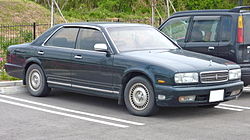
Also called Nissan Gloria Production 1991.06-1995.08 Body style 4-door hardtop Layout FR layout Engine 2.0 L VG20E V6
3.0 L VG30DET V6
3.0 L VG30DE V6
3.0 L VG30E V6
2.8 L Straight-6 dieselTransmission 4 speed automatic
5 speed automaticWheelbase 2,760 mm (108.7 in) Length 4,800 mm (189.0 in) Width 1,745 mm (68.7 in)) Height 1,405 mm (55.3 in) Curb weight 1,660 kg (3,700 lb) Related Nissan Crew
Nissan Cima Y32
Nissan Leopard Y32The Y32 Cedric, only ever available in a Hardtop version aimed at private buyers, was a reskin of the Y31 model. The Y31 Sedan continued in production alongside the Y32, intended for commercial and institutional uses. The Cedric had a market reputation appealing to an older demographic, while the sister car Nissan Gloria, which has a more performance oriented reputation, aimed for younger buyers. This model shared much of its mechanicals with the newly released Cedric Cima which was a sales success for Nissan. The Y32 was produced from June 1991 through 1994. It has had SOHC and DOHC versions of the VG series V6, alongside with the inline six Diesel 2.8 version. A four-cylinder engine was never available as the Y32 was only ever marketed in more upscale versions. The performance oriented Gran Turismo reverted back to four round headlights, giving the vehicle a similar appearance to the BMW 7-series sedan sold at the time. Manual transmissions were no longer available. Power window switches were illuminated for easy location at night. The parking brake was no longer operated by center mounted hand operated handle, instead relocated to a pedal next to the brake pedal. Interior lighting operates gradually when any door is opened, a shortwave radio tuner is included with the stereo system, and maintenance reminders are also added.
In September 1994 and January of the following year, Granturismo and Brougham versions of the lesser two-litre six-cylinder version were added. Production ended in August 1995 after the June introduction of the succeeding Y33 Cedric Hardtop.[9] The Y31 Sedan remained in production for commercial use.
Engines:
- 2.0 L VG20E, 125 PS (92 kW) at 6,000 rpm[10]
- 3.0 L VG30E, 160 PS (118 kW) at 5,200 rpm[11]
- 3.0 L VG30DE, 200 PS (147 kW) at 6,000 rpm[12]
- 3.0 L VG30DET, 255 PS (188 kW) at 6,000 rpm[13]
- 2.8 L RD28, 100 PS (74 kW) at 4,800 rpm[14]
Ninth generation Y33
Nissan Cedric Y33 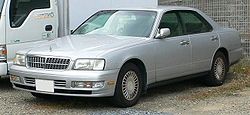
Also called Nissan Gloria Production 1995.06-1999.08[9] Body style 4-door hardtop Layout FR layout Engine 3.0 L VQ30DET V6
3.0 L VQ30DE V6
3.0 L VQ25DE V6
2.0 L VQ20DE V6
2.8 L Straight-6 dieselTransmission 5 speed automatic Wheelbase 2,760 mm (108.7 in) Length 4,800 mm (189.0 in) Width 1,745 mm (68.7 in)) Height 1,405 mm (55.3 in) Curb weight 1,660 kg (3,700 lb) Related Nissan Crew
Nissan Cima Y33
Nissan Leopard Y33The Y33 was sold from June 1995 through June 1999. The VG series engine was replaced with the newly developed VQ series (except for the initial lower level versions). AWD ATTESA E-TS, also found on the Skyline, Laurel and Stagea, was added to the options list. One of the major advantages of the VQ series over the VG series was the aluminum alloy block and heads, helping to reduce weight. This generation of the Cedric was also built in LHD for export to Middle East markets. Export versions generally received the VG30E engine, with outputs from 130 to 143 PS (96 to 105 kW) depending on the octane rating.[15]
Engines:
Tenth generation Y34
Nissan Cedric Y34 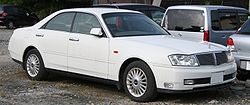
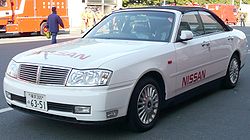
Also called Nissan Gloria Production 1998–2004 Body style 4-door hardtop Layout FR layout/AWD Engine 2.5 L V6 VQ25DD LEV
2.5 L I-6 RB25DET
3.0 L V6 VQ30DD LEV
3.0 L V6 VQ30DET LEVTransmission 4 speed automatic Wheelbase 2,800 mm (110.2 in) Length 4,860 mm (191.3 in) Width 1,770 mm (69.7 in)) Height 1,440 mm (56.7 in) Curb weight 1,710 kg (3,800 lb) The Y34 entered production in 1998 and lasted through 2004.
The line-up consisted of the 250L and LV (naturally aspirated 2.5 litre V-6), 300LV (naturally aspirated 3 litre V-6) and 300LX/300VIP (3 litre turbo V-6), all with rear wheel drive; additionally there was the 250L/LV Four featuring all-wheel-drive and a turbocharged version of Nissan's 2.5 litre inline six also seen in the Skyline. Direct injection is added to all V6 engines for improved performance and reduced emissions, signified by the "DD" designation in the engine model number. AWD is only available on vehicles equipped with the RB25DET engine. A CVT transmission was available on the 300 VIP-Z and 300 LX-ZS trim levels. Top level Cedrics are comparable to the parallel line Nissan Cima, which occupies a market slot just beneath the Nissan President. Autech released a special 40th anniversary version of the Cedric, with the VQ30DET engine.
Satellite guided navigation is added to this generation.
In October 2004, the last Cedric hardtop was built, after which it was replaced by the Nissan Fuga. The Cedric nameplate remains available on the Y31-series sedans, and is currently only available for commercial users.
Prices (in 1999) ranged from ¥3,110,000 for a base 250 L to ¥4,940,000 for the ultra-luxurious 300VIP.
References
- ^ a b c d (in Japanese) Car Graphic: Car Archives Vol. 1, '60s Japanese/American Cars. Tokyo: Nigensha. 2000. p. 17. ISBN 978-4-544-09171-3.
- ^ Nissan Cedric 230 catalog, Nissan Motor Company 1973.
- ^ a b c Büschi, Hans-Ulrich, ed (March 10, 1983). Automobil Revue '83. 78. Berne, Switzerland: Hallwag, AG. pp. 410–411. ISBN 3-444-06065-3.
- ^ Mastrostefano, Raffaele, ed (1990) (in Italian). Quattroruote: Tutte le Auto del Mondo 1990. Milano: Editoriale Domus S.p.A. p. 1193.
- ^ a b "Goo-net Catalog: Nissan Cedric Wagon". Goo-net. http://www.goo-net.com/catalog/NISSAN/CEDRIC_WAGON/index.html. Retrieved 2011-01-31.
- ^ "Goo-net Catalog: Nissan Cedric Wagon 28D·6 GL". Goo-net. http://www.goo-net.com/catalog/NISSAN/CEDRIC_WAGON/1503143/index.html. Retrieved 2011-01-31.
- ^ "240 Landmarks of Japanese Automotive Technology - Full range electronically controlled 5-speed automatic (mounted on Nissan Cedric Y31)". Jsae.or.jp. http://www.jsae.or.jp/autotech/data_e/8-8e.html. Retrieved 2010-12-26.
- ^ "Goo-net Catalog: Nissan Cedric Classic". Goo-net. http://www.goo-net.com/catalog/NISSAN/CEDRIC/1505411/index.html. Retrieved 2011-01-31.
- ^ a b "Goo-net Catalog: Nissan Cedric". Goo-net. http://www.goo-net.com/catalog/NISSAN/CEDRIC.html. Retrieved 2011-01-31.
- ^ "Goo-net Catalog: Nissan Cedric V20E Classic". Goo-net. http://www.goo-net.com/catalog/NISSAN/CEDRIC/1500772/index.html. Retrieved 2011-01-31.
- ^ "Goo-net Catalog: Nissan Cedric V30E Granturismo". Goo-net. http://www.goo-net.com/catalog/NISSAN/CEDRIC/1500737/index.html. Retrieved 2011-01-31.
- ^ "Goo-net Catalog: Nissan Cedric V30 Twin Cam Brougham". Goo-net. http://www.goo-net.com/catalog/NISSAN/CEDRIC/1500709/index.html. Retrieved 2011-01-31.
- ^ "Goo-net Catalog: Nissan Cedric V30 Twin Cam Turbo Brougham V". Goo-net. http://www.goo-net.com/catalog/NISSAN/CEDRIC/1500722/index.html. Retrieved 2011-01-31.
- ^ "Goo-net Catalog: Nissan Cedric RD28 Brougham J". Goo-net. http://www.goo-net.com/catalog/NISSAN/CEDRIC/1500732/index.html. Retrieved 2011-01-31.
- ^ a b Büschi, Hans-Ulrich, ed (March 6, 1997) (in German/French). Automobil Revue 1997. 92. Berne, Switzerland: Hallwag AG. p. 410. ISBN 3-444-10479-0.
- ^ "Goo-net Catalog: Nissan Cedric Brougham 1995.6-1996.8". Goo-net. http://www.goo-net.com/catalog/NISSAN/CEDRIC/1500532/index.html. Retrieved 2011-01-31.
External links
- Planet Cedric
- Nissan Sedan history (japanese site)
- RatDat.com - paint colors, sales brochures, and model names
Nissan Motor Company Vehicles Current370Z • Advan • Altima • Aprio • Armada • Atlas • Bluebird • Bluebird Sylphy • Cabstar • Caravan • Civilian • Clipper • Cube • Dualis • Elgrand • Frontier • Freeson • Fuga • GT-R • Juke • Lafesta • Leaf • Livina Geniss • Maxima • March • Murano • Moco • Navara • Note • NV200 • NV400 • Otti • Paladin • Pathfinder • Patrol • Qashqai • Quest • Rogue • Safari • Sentra • Serena • Skyline • Teana • Tiida • Titan • Urvan • Versa • Wingroad • X-Trail • XterraPastDC-3 • 100NX • 1200 • 310 • 180SX • 200SX • B-210 • 240SX • 240Z • 280ZX • 300C • 300ZX • 350Z • 510 • 810 • Almera • Almera Tino • Altra (EV) • Avenir • Auster • Bassara • Be-1 • Caball • Cablight • Cedric • Cefiro • Cherry • Cima • Crew • Datsun Truck • Echo • Expert • Fairlady • Figaro • Gazelle • Gloria • Hardbody Truck • Hypermini • Homy • Interstar • Junior • Largo • Laurel • Leopard • Liberty • Mistral • Multi • NX • Pao • Pintara • Pino • Platina • Prairie • Presage • Presea • Primera • President • Pulsar • Pulsar GTI-R • R390 GT1 • R'nessa • Rasheen • Roadster-Road Star • S-Cargo • Saurus • Saurus Jr • Silvia • Sileighty • Skyline GT-R • Stanza • Stagea • Sunny • Terrano • Terrano II • Vanette • VioletConcept126X • 216X • 270X • 300 Bambu • 315-a • AA-X • Actic • AD-1 • AD-2 • AL-X • Alpha T • Amenio • AQ-X • AP-X • ARC-X • AXY • AZEAL • Bevel • Boga • C-Note • Chapeau • Chappo • Cocoon • CQ-X • Crossbow • CUE-X • Cypact • Duad • Dunehawk • Effis • ESV • Evalia • EV Guide II • EV Truck • FEV • FEV-II • Foria • Forum • Fusion • Gobi • GR-1 • GR-2 • GT-R • ideo • Intima • Jikoo • Judo • Jura • Kino • KYXX • Land Glider • LEAF • LUC-2 • MID4 • Mixim • mm.e • Moco • Nails • NCS • NEO-X • NRV-II • NX-21 • NV2500 • Pivo • Pivo 2 • Qazana • Redigo • Round Box • Serenity • Sport Concept • Stylish VI • Terranaut • Tone • Townpod • Trailrunner • TRI-X • URGE • UV-X • XIX • XVL • Yanya • ZarootEngines GRX-3 • UD12 • VRT35Marques Nissan • InfinitiSubsidiaries
and divisionsSee also ATTESA • Datsun • HICAS • Prince • Renault-Nissan Alliance • Nissan Shatai • UD Nissan Diesel • VVL • VVEL • dCi
Categories:- Nissan vehicles
- Full-size vehicles
- Luxury vehicles
- Executive cars
- Vehicles with CVT transmission
- Vehicles introduced in 1960
Wikimedia Foundation. 2010.









